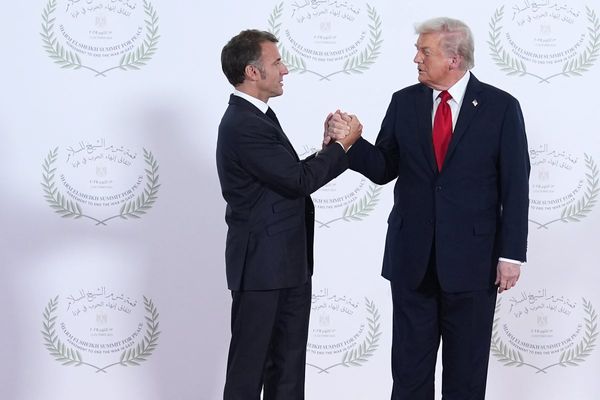
“This is one of the most critical stages in women’s golf history.”
Those were the words of NBC’s lead golf play-by-play voice Dan Hicks on a conference last Wednesday promoting this week’s U.S. Women’s Open.
A day later, the LPGA named a new commissioner: Craig Kessler.
Kessler will become the tour’s 10th commissioner in its 75-year history. The 39-year-old was previously the chief operating officer at Topgolf from 2016–21 before serving as the chief commercial officer for the PGA of America.
And he has his work cut out for him.
“I think if the team—and the team I use in the broadest sense. It’s the players, it’s the sponsors, it’s the staff, it’s the media,” Kessler said in his introductory press conference. “If together we’re aligned on a handful of very clear priorities that ladder up to a vision, the future is incredibly bright.
Kessler takes over for Mollie Marcoux Samaan, who stepped down in January after holding the position since 2021. She followed Mike Whan’s 11 years at the helm, where he took the circuit to new heights.
Some are yearning for a similar approach from Kessler.
“I think Mike Whan, obviously now has a new role [as USGA CEO], but I think that he had it right when he came in and brought on the ‘Act Like a Founder’ mantra that the players really kind of took on board,” Golf Channel analyst and two-time LPGA winner Karen Stupples said, “because it created an atmosphere of—I don’t want to say gratitude, but it certainly was—there was a vibe of enjoying being out on the golf course, be happy to be there, thankful to the sponsors that they believed in women’s golf and everything else, and I think that that’s a good place to come from.”
Samaan had big shoes to fill, and there was a consensus during her tenure that LPGA leadership lacked communication across the board. Kessler plans to rectify that.
LPGA Board of Directors Elects Craig Kessler as Commissioner
— LPGA (@LPGA) May 22, 2025
Kessler will be the 10th LPGA Commissioner and has been selected to lead the LPGA's next era of global growth
MORE ⬇️ https://t.co/gb8Rf134Af
“What I learned from the players as I went through the process, I think the No. 1 theme is making sure that the players have a remarkable relationship with their commissioner and the staff,” said Kessler, who will start on July 15. “That is priority No. 1 and there are examples of where that’s happening in spades.”
The tour continued to evolve under Samaan with missed-cut stipends, domestic travel stipends and fully subsidized health insurance. Most notably, though, there was a significant uptick in purse sizes. In 2021, the LPGA awarded roughly $76 million in prize money. This year, it’s $131 million.
The total purse size has jumped 227% since Whan took over 15 years ago. For good measure, it wasn’t until the 1990 Centel Classic that the LPGA had a $1 million purse for a regular tour event.
But issues persist.
Fixing the schedule
When Kessler was asked about an aspect of the LPGA that could be improved, he didn’t hesitate to answer.
“Another theme that’s come up quite a bit is around schedule,” Kessler said, “and optimizing the schedule so that it makes sense. It’s rational. It allows our athletes to perform at the highest levels and to recover as opposed to zigzagging the country or the world.”
Players echo that sentiment.
“Looking forward to having just a new leader and maybe some updates to the schedule,” said Yealimi Noh, a first-time winner in February, at the Mizuho Americas Open earlier this month. “I know it’s getting better every year.”
At this point in the season, the LPGA just went from New Jersey to Mexico, with a week off in between, and is now in Wisconsin before heading back to New Jersey. Next month, two events in Michigan will sandwich the KPMG Women’s PGA Championship in Texas.
“When it comes to schedule, just the flow in it,” Nelly Korda said in January. “When we’re on the West Coast, having a flow in the West Coast schedule, having all our events kind of aligned so we’re not traveling from coast to coast in the U.S., I think with scheduling it’s just about making it a little easier for us with travel.”
Also, four of the first eight tournaments of the season are limited-field events, granting a handful of players limited opportunities to get reps under their belt before the year’s first major, the Chevron Championship.
Of course, that’s all easier said than done. Venues have to be willing to hand over their courses during ideal points of the year, with their membership agreeing. And the location has to have the proper logistics and bandwidth to host a tournament.
But at least Kessler hears players’s concerns and is striving for a remedy.
“I’ve got a long list of things to approach with our landscape team when I start,” he said. “(The schedule) will certainly make it to the top of the list.”
What else is on his agenda?
Riding the wave in women’s sports
At a time when women’s sports are booming, there’s a feeling that the LPGA didn’t maximize its potential.
“You had an incredible year by Nelly Korda last year that maybe wasn’t fully taken advantage of,” Hicks said, “and with the Caitlin Clarks and the WNBA and the rest of the world of women’s sports I think exploding, this is the time for women’s golf to make a move, and you’ve got to be creative.”
And Korda believes that’s something the new commissioner should prioritize.
“I think just capitalizing on the growth of women’s sports,” Korda, the world No. 1, said at the Mizuho Americas Open. “A lot of people are really eager to invest and finding the right partners that are long-lasting partners that really love the tour, love the product, and want to grow with us, I think is really important and that’s for the commissioner to find.”
Recently, there’s been some turbulence regarding sponsors. Cognizant pulled its title sponsorship from the Founders Cup in 2024 after making the purse the largest on tour besides the majors and the Tour Championship. The event then moved from New Jersey to Florida, replacing the Drive On Championship, with the purse dropping from $3 million to $2 million. The LPGA backed the event and the U.S. Virgin Islands stepped in as presenting sponsor at the last minute. Events in Arizona and Portland, Ore., have also faced uncertainty, but Ford and The Standard have stepped in as title sponsors. Ford, however, only signed for one year in 2024, but returned for 2025.
In addition, earlier this year, the FIR Hills Seri Pak Championship in Los Angeles was cancelled because of financial neglect from the tournament’s underwriter.
On the flip side, this year’s inaugural Black Desert Championship had a $3 million purse, along with comped rooms and free chartered flights for players. That event came after the Chevron Championship, in which the oil corporation signed a six-year deal in 2021 and raised the purse to $5 million.
However, crowds at multiple events such as the Chevron Championship have been lackluster, and that can depreciate the television product. Many non-major events are already hampered by limited broadcast windows that aren’t on network TV.
Gathering interest both on-site and at home goes hand in hand.
“You’ve got to have continuity,” Golf Channel play-by-play commentator Grant Boone said. “There’s a reason why people go to the [PGA Tour’s CJ Cup Byron Nelson] in Dallas every year. It’s because they've always gone. Then they keep bringing their kids, and then the next thing you know, it just swells and swells.
“One of the reasons, for example, why the Premier League has grown in popularity in America, when you flip it on, you can find it more easily on television than you used to see it in the States. When you flip it on and you see 30, 40, 50,000 or more people going crazy, you think, ‘I don’t even know what they’re doing, but if that many people care that much about it, maybe I’ll stay for a few extra minutes and watch it.’”
But one thing’s certain: the LPGA isn’t bereft of talent.
“How do we do everything that we can to grow the organization, to get more eyeballs on the tour to promote it?” major champion and Golf Channel analyst Morgan Pressel said. “Because we do have to work harder than other sports, and certainly men’s golf in that sense, to get people to pay attention.
“Look at the talent that we have on tour right now. It is exceptional. So, I think between a cultural buy-in from the players through this new commissioner, as well as being able to capitalize really on the superstars.”
Kessler’s vision
To achieve his vision for the tour, Kessler will utilize four pillars.
“The first pillar,” he said, “the first building block is around building trust, trust with our players, our sponsors, trust with our fans, and trust with our team.
“The second major pillar is around being visible and making sure that the incredible stars the LPGA has who leave it on the course week in and week out are actually visible, and that goes even beyond just the broadcasts.
“The third pillar is around building fans, and I’ll tell you, there is a fundamental difference—today, many people watch the LPGA and we want people to root for the LPGA and the incredible players that are on tour week in and week out.
“Then the fourth and final pillar is around building a financial future that looks even better for the next 75 years than it has for the last.”
And he welcomes anyone to jump on board (that even includes Saudi Arabia’s Public Investment Fund, which bankrolls LIV Golf and has invested in the Ladies European Tour).
“Any organization that wants to elevate our athletes in the LPGA,” he said. “I can’t wait to have a discussion with folks who are willing to do it.”
That energy and mindset have players bullish about what lies ahead.
“I think what we’re lacking,” Brittany Lincicome told Sports Illustrated last month, “somebody coming in and kind of like a Mike Whan, where it was, ‘How can I help you? What do you need me to do? How do I make the tour better?’ And not how I further my career.
“So somebody that comes in and really cares about the players and trying to help us all as a whole grow and not just themselves.”
In 1950, 13 women founded the tour and ran the entire operation while tirelessly promoting it across the country. In one instance, Marilyn Smith and Shirley Spork jumped into a boxing ring to tell people to attend their tournament.
Seventy-five years later, the LPGA, despite some roadblocks along the way, has become the most successful women’s sports league, essentially without any assistance from the men’s game. Now, Kessler will be tasked with ushering in the next phase of the storied organization.
With the tour at a crossroads, there are high hopes for Kessler’s tenure, and his hands will be full from the get-go.
“It’s a tricky business,” Golf Channel on-course commentator and former LPGA player Kay Cockerill said. “The commissioner has to answer to all these women, and you can never make a whole body of women happy, and you have to engage with the sponsors and with the people and keep selling our sport.”
This article was originally published on www.si.com as There’s Excitement Around the New LPGA Commissioner, Who Will Have His Hands Full .







